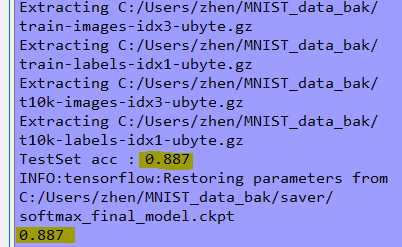标签:restore 一个 结果 而不是 最大值 oat ast .so cas
1 # -*- coding: utf-8 -*- 2 """ 3 Created on Thu Oct 18 18:02:26 2018 4 5 @author: zhen 6 """ 7 8 from tensorflow.examples.tutorials.mnist import input_data 9 import tensorflow as tf 10 11 # mn.SOURCE_URL = "http://yann.lecun.com/exdb/mnist/" 12 my_mnist = input_data.read_data_sets("C:/Users/zhen/MNIST_data_bak/", one_hot=True) 13 14 # The MNIST data is split into three parts: 15 # 55,000 data points of training data (mnist.train) 16 # 10,000 points of test data (mnist.test), and 17 # 5,000 points of validation data (mnist.validation). 18 19 # Each image is 28 pixels by 28 pixels 20 21 # 输入的是一堆图片,None表示不限输入条数,784表示每张图片都是一个784个像素值的一维向量 22 # 所以输入的矩阵是None乘以784二维矩阵 23 x = tf.placeholder(dtype=tf.float32, shape=(None, 784)) 24 # 初始化都是0,二维矩阵784乘以10个W值 25 W = tf.Variable(tf.zeros([784, 10])) 26 b = tf.Variable(tf.zeros([10])) 27 28 y = tf.nn.softmax(tf.matmul(x, W) + b) 29 30 # 训练 31 # labels是每张图片都对应一个one-hot的10个值的向量 32 y_ = tf.placeholder(dtype=tf.float32, shape=(None, 10)) 33 # 定义损失函数,交叉熵损失函数 34 # 对于多分类问题,通常使用交叉熵损失函数 35 # reduction_indices等价于axis,指明按照每行加,还是按照每列加 36 cross_entropy = tf.reduce_mean(-tf.reduce_sum(y_ * tf.log(y), 37 reduction_indices=[1])) 38 train_step = tf.train.GradientDescentOptimizer(0.5).minimize(cross_entropy) 39 40 # 评估 41 42 # tf.argmax()是一个从tensor中寻找最大值的序号,tf.argmax就是求各个预测的数字中概率最大的那一个 43 44 correct_prediction = tf.equal(tf.argmax(y, 1), tf.argmax(y_, 1)) 45 46 # 用tf.cast将之前correct_prediction输出的bool值转换为float32,再求平均 47 accuracy = tf.reduce_mean(tf.cast(correct_prediction, tf.float32)) 48 49 # 初始化变量 50 sess = tf.InteractiveSession() 51 tf.global_variables_initializer().run() 52 # 创建Saver节点,用于保存训练的模型 53 saver = tf.train.Saver() 54 for i in range(100): 55 batch_xs, batch_ys = my_mnist.train.next_batch(100) 56 sess.run(train_step, feed_dict={x: batch_xs, y_: batch_ys}) 57 # 每隔一段时间保存一次中间结果 58 if i % 10 == 0: 59 save_path = saver.save(sess, "C:/Users/zhen/MNIST_data_bak/saver/softmax_middle_model.ckpt") 60 61 # print("TrainSet batch acc : %s " % accuracy.eval({x: batch_xs, y_: batch_ys})) 62 # print("ValidSet acc : %s" % accuracy.eval({x: my_mnist.validation.images, y_: my_mnist.validation.labels})) 63 64 # 测试 65 print("TestSet acc : %s" % accuracy.eval({x: my_mnist.test.images, y_: my_mnist.test.labels})) 66 # 保存最终的模型 67 save_path = saver.save(sess, "C:/Users/zhen/MNIST_data_bak/saver/softmax_final_model.ckpt") 68 69 # 使用训练好的模型直接进行预测 70 with tf.Session() as sess_back: 71 saver.restore(sess_back, "C:/Users/zhen/MNIST_data_bak/saver/softmax_final_model.ckpt") 72 # 评估 73 correct_prediction = tf.equal(tf.argmax(y, 1), tf.argmax(y_, 1)) 74 accruary = tf.reduce_mean(tf.cast(correct_prediction, tf.float32)) 75 # 测试 76 print(accuracy.eval({x : my_mnist.test.images, y_ : my_mnist.test.labels})) 77 # 总结 78 # 1,定义算法公式,也就是神经网络forward时的计算 79 # 2,定义loss,选定优化器,并指定优化器优化loss 80 # 3,迭代地对数据进行训练 81 # 4,在测试集或验证集上对准确率进行评测
结果:

解析:
把训练好的模型存储落地磁盘,有利于多次使用和共享,也便于当训练出现异常时能恢复模型而不是重新训练!
TensorFlow实现Softmax回归(模型存储与加载)
标签:restore 一个 结果 而不是 最大值 oat ast .so cas
原文地址:https://www.cnblogs.com/yszd/p/9822365.html